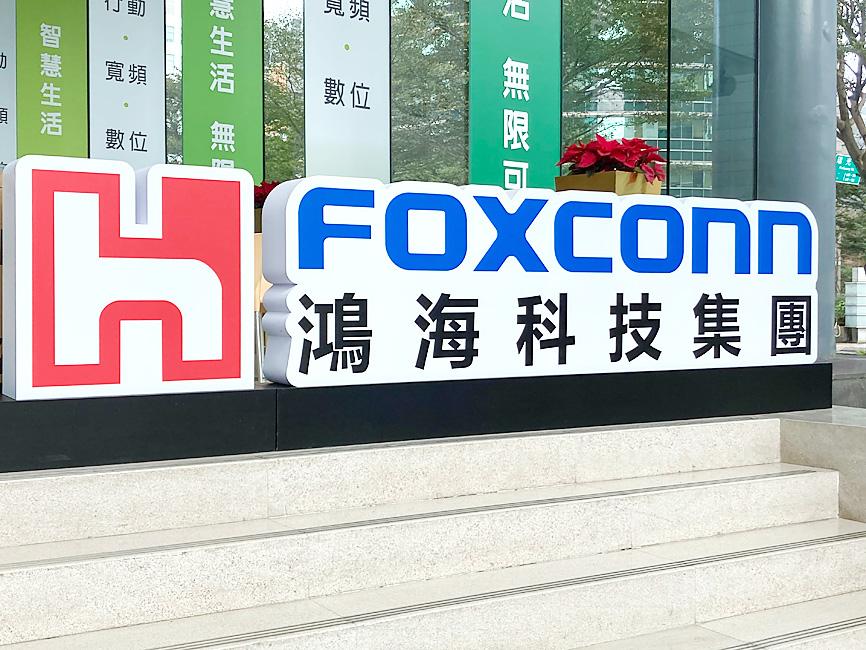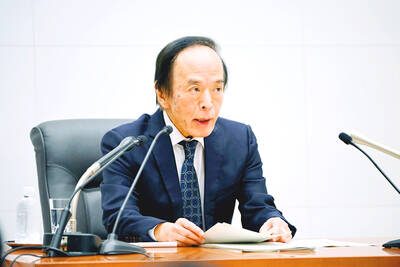Hon Hai Precision Industry Co (鴻海精密) yesterday reported revenue of NT$401.62 billion (US$14.39 billion) for last month, down 11.74 percent month-on-month, but up 11.40 percent year-on-year.
Last month’s figure marked a record-high June for Hon Hai, which the company attributed to a strong showing from its consumer electronics business, followed by its components and cloud network segments.
BENEFICIAL TRENDS

Photo: Chen Rou-chen, Taipei Times
The world’s largest contract electronics maker and major iPhone assembler is benefiting from continued demand for high-end servers and laptops, iPhone 12s and 5G base stations, as consumers snatch up devices for remote work and schooling, as well as entertainment, while companies invest in technology, expanding data center infrastructure to better serve customers’ online activities, analysts said.
Revenue in the second quarter was NT$1.36 trillion, up 0.7 percent from the previous quarter and also increasing 20.3 percent from a year earlier to reach the highest for the April-to-June period, Hon Hai said.
Year-to-date revenue totaled NT$2.7 trillion, up 31.21 percent from the same period last year, the company said in a statement.
LARGAN REVENUE DOWN
Separately, Largan Precision Co (大立光) reported revenue of NT$3.37 billion for last month, up 0.35 percent from the previous month but 18.51 percent lower than a year earlier, which was in line with the company's guidance.
The smartphone camera lens supplier’s second-quarter revenue was NT$10.11 billion, down 14.4 percent from the previous quarter and also down 20.1 percent from a year earlier, with revenue in the first half of the year decreasing 15.2 percent to NT$21.93 billion, Largan said in a statement.
The company, which plans to hold an investors’ conference on Thursday, said that second-quarter revenue was the lowest in nearly nine quarters but expected this month to be better than last month as customers begin to purchase lenses for new handset models.
High-end products of 20 megapixels or greater accounted for 20 to 30 percent of the company’s sales last month, and 10 to 20-megapixel lenses accounted for 50 to 60 percent of sales, while 8-megapixel products accounted for less than 10 percent, and products in the “other” category made up 10 to 20 percent.
QISDA REVENUE RISES
Contract electronics maker Qisda Corp (佳世達) said in a regulatory filing that revenue reached NT$20.5 billion last month, increasing 13.06 percent from May and 32.59 percent from a year earlier.
The company attributed the increase to strong demand for products, as well as contributions from subsidiaries.
Revenue in the second quarter grew 28 percent year-on-year to NT$56 billion, while cumulative revenue in the first six months increased 28.98 percent to NT$106.89 billion, it said.

Taiwan Semiconductor Manufacturing Co (TSMC, 台積電) last week recorded an increase in the number of shareholders to the highest in almost eight months, despite its share price falling 3.38 percent from the previous week, Taiwan Stock Exchange data released on Saturday showed. As of Friday, TSMC had 1.88 million shareholders, the most since the week of April 25 and an increase of 31,870 from the previous week, the data showed. The number of shareholders jumped despite a drop of NT$50 (US$1.59), or 3.38 percent, in TSMC’s share price from a week earlier to NT$1,430, as investors took profits from their earlier gains

In a high-security Shenzhen laboratory, Chinese scientists have built what Washington has spent years trying to prevent: a prototype of a machine capable of producing the cutting-edge semiconductor chips that power artificial intelligence (AI), smartphones and weapons central to Western military dominance, Reuters has learned. Completed early this year and undergoing testing, the prototype fills nearly an entire factory floor. It was built by a team of former engineers from Dutch semiconductor giant ASML who reverse-engineered the company’s extreme ultraviolet lithography (EUV) machines, according to two people with knowledge of the project. EUV machines sit at the heart of a technological Cold

TAIWAN VALUE CHAIN: Foxtron is to fully own Luxgen following the transaction and it plans to launch a new electric model, the Foxtron Bria, in Taiwan next year Yulon Motor Co (裕隆汽車) yesterday said that its board of directors approved the disposal of its electric vehicle (EV) unit, Luxgen Motor Co (納智捷汽車), to Foxtron Vehicle Technologies Co (鴻華先進) for NT$787.6 million (US$24.98 million). Foxtron, a half-half joint venture between Yulon affiliate Hua-Chuang Automobile Information Technical Center Co (華創車電) and Hon Hai Precision Industry Co (鴻海精密), expects to wrap up the deal in the first quarter of next year. Foxtron would fully own Luxgen following the transaction, including five car distributing companies, outlets and all employees. The deal is subject to the approval of the Fair Trade Commission, Foxtron said. “Foxtron will be

INFLATION CONSIDERATION: The BOJ governor said that it would ‘keep making appropriate decisions’ and would adjust depending on the economy and prices The Bank of Japan (BOJ) yesterday raised its benchmark interest rate to the highest in 30 years and said more increases are in the pipeline if conditions allow, in a sign of growing conviction that it can attain the stable inflation target it has pursued for more than a decade. Bank of Japan Governor Kazuo Ueda’s policy board increased the rate by 0.2 percentage points to 0.75 percent, in a unanimous decision, the bank said in a statement. The central bank cited the rising likelihood of its economic outlook being realized. The rate change was expected by all 50 economists surveyed by Bloomberg. The